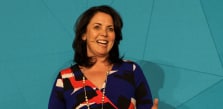Growing up, all I ever wanted was to become a pro photographer.
I dreamed of working for National Geographic.
I imagined a life of adventure and excitement, capturing wild, one-of-a-kind images out in the African Savannah, up in the Himalayas, or across the deserts of the Middle East.
I imagined what it would feel like to do what I truly loved. I’d get to express my creativity and share the breathtaking beauty of the world with millions of people…
And I’d actually get well paid for my work.
It would be perfect.
When I got to college, I held on to that dream.
I knew that if I wanted be a National Geographic photographer, I’d have to be more than good, more than great…
I’d have to be exceptional.

So, I lived and breathed photography and spent every spare second, taking pictures of everything around me.
You could NOT have paid me to stop and I thought I never would.
But then again… never say never.
I think it was my third year in college when I read a book that totally changed my mind about being a photographer.
It was called Perspective As Symbolic Form — a fascinating study that applied the Law of Diminishing Returns to art movements.
The Law of Diminishing Returns is a concept in economics, which says that there comes a point when increased production and input will start to create a decline in output.
Translation: the more you produce, the less impact you create.
In art, this means you could introduce a valuable, impactful, style of art but as it catches on and as more and more people start to adopt it, your innovative, exciting new style steadily becomes less impactful and less valuable.
When the truth of this idea sank in, I suddenly realized this was going to happen with photography.
Even back when I was in college in the late 90s, it was obvious that photography was becoming less and less an exclusive art form that belonged to a group of professionals and more and more a form of creative expression that belonged to everyone.
In that single, blinding moment of clarity, I put away my camera.
I’ve hardly touched it since (and it’s one of the reasons you don’t see me much on Instagram!) — not even to take selfies!
I was devastated, yes, but I’m not a “head in the sand” kind of person and I couldn’t ignore the truth…
It was clear that photography was no longer going to be a viable career path for me in the long-term… and I was right.
Here are some recent stats that back up my decision…

SOURCE: Statista
Reading Perspective As Symbolic Form also made me realize that the Law of Diminishing Returns wouldn’t just affect art and media, it would spread to other industries and professions.
I knew that, sooner or later, we’d hit a state of information overload or what I like to call “peak information”
Peak information happens when there’s SO much information available that the situation hits a maximum point and more information is no longer valued by the consumer.
In 1982, visionary and inventor Buckminster Fuller introduced his “knowledge-doubling curve” where he explained how knowledge was doubling every 12 months.
More recently, research by IBM added important details to Fuller’s theory…
Before World War 2 information doubled every 100 years, after 1945 it doubled every 25 years, and by 2020, information will likely be doubling every 11 to 12 hours.
Look around and you’ll see it happening right now… we’re battling information overload in every area.
Peak information has hit every media and art form and it’s spread to all forms of creation and transfer of information.
So, what does this mean for entrepreneurs like us?
In a world of peak information, how do you market yourself?
In a world where people are increasingly feeling “numbed out” by an endless flood of information, how do you get someone to learn from you, much less take action on what they learn?
How do you get them to buy from you?
And here’s the big one…
In a world where information on anything and everything is available in seconds, how can you ever hope to build a business that doesn’t go OUT of business in 6 months… or less?
Those are some pretty scary questions…
But there are answers.
You can escape the effects of the Law of Diminishing Returns and peak information when you:
#1: Connect with Your Audience

Your business should be less about sharing information through products and programs and more about building heart-to-heart connections with people — either online or in person. (Check out my video blog It’s Not the Size of the List that Matters for more on this.)
Think about how you can share some of your personal stories so your audience can get to know the real you (if you want to learn to write powerful stories that inspire emotion and genuine connections, check out my free Definitive Guide to Storytelling for Business).
Allow yourself to get vulnerable and let your unique personality shine through.
Think authentic expression over “plastic perfection.”
The more your audience sees the real you, the more they’ll feel understood, engaged and inspired to buy from you.
#2: Motivate Your Audience to Take Action
Get people to take action by leveraging the power of experienficiation in your business.
Experiencification is about getting people engaged and involved in all your content.
One of the most effective ways to do this is to get people to take action in all aspects of your marketing and every, single time you offer free content.
Research by Data Scientists shows that when you get people to commit to taking 3 micro actions, they’ll see results from your teachings and content, start seeing you as the expert that you are…
And buy from you again and again (for more on experiencification check out my video blog Why Information is Quietly Killing Your Business).
I took my business from zero all the way up to the 7-figure mark (and now we’re rapidly moving into mid-7-figure territory) based on these 2 principles.
I’ve also taught countless entrepreneurs to do the same.
We’ve collectively created tens of millions of dollars from products, courses and programs that inspire audiences to buy again and again and here’s why…
Just about every information product out there is about passive consumption.
But when you do what it takes to truly connect with people and get them into action, you’ll easily stand out from the crowd, attract raving fans and returning customers, create phenomenal results in terms of income and impact.
And most important of all…
You’ll short circuit the peak information phenomenon and build a highly successful business that lasts.
Way back in the 70s, futurist and author Alvin Toffler predicted that…
“The illiterate of the 21st century will not be those who cannot read and write, but those who cannot learn, unlearn, and relearn.”
The path to success that lasts is the path of adaptation, adjustment and alteration.
It’s time to unlearn what we think we know about information transfer and relearn what actually works in the real world, right now.
Your turn…
How can you short circuit peak information in your business?
How can you connect more authentically and powerfully with your audience and get people to take action — at least 3 micro actions — in your marketing and content so they’ll feel excited and inspired to buy from you?
Share your thoughts, ideas and “a-has” in the comments!
Love it? Hate it? Let me know...
-
Loved this article Marisa; It made a lot of sense now that I am planning to go “global” with my offerings…thanks & much love
-
So glad Raja! What are you offering?
-
-
Great information Marisa,I have good life story and an old self help classic which I want to share with the world,but being 72 years “young”:) I am still a newbie online and would need some help….
-
Totally get that. We are now in the experience economy! So can totally see why creating an experience for your customers is part of the remedy! Thanks for an insightful post!
-
Yep! Love that — experience economy. It’s so important and what people are really craving.
-



























Leave a Comment